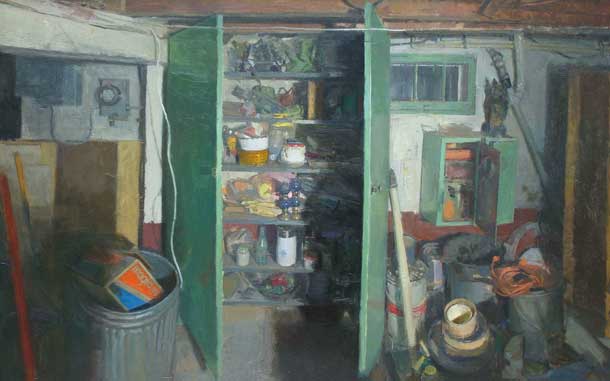
Matt Klos Treasure Chest oil on panel 19″ x 30″ click here for a larger view
Many thanks to Matt Klos, a very strong emerging painter in Maryland who was generous to take the time to do an email interview. He also provided me with a video where he discusses one of his basement interiors, additionally there is another video made was made by his friend, David Campbell, as part of his work with ArtPneuma….
Matt Klos studied at the University of Maryland for his MFA and the Columbus College of Art and Design for his BFA. He currently lives in Baltimore, Maryland where he heads the Art Department at Anne Arundel Community College.
Matt Klos show with the McBridge Gallery in Annapolis, MD and recently had a solo show at the New York Prince Street Gallery. He also recently painted in the Brittany region of France, sponsored through the Klots Residency program, awarded and facilitated by the Maryland Institute College of Art. Matt Klos’ work has been featured in New American Paintings in the 2009 Mid-Atlantic edition and in New American Paintings in the 2006 Mid-West edition.
Larry Groff: Your interiors are filled with delightful visual surprises and have a remarkable geometric structure and tonal unity despite the visual chaos typical of basement and kitchen clutter. Can you tell us something about what you are trying to get at with these pictures.
Matt Klos: Really, the interior is my platform for unpacking a number of visual paradoxes… and visual pleasures. The empty interiors of Daylight Studio were about the openness of spaces and the paradox of the flat geometric design. I would try to carefully depict, for example, the tusk like roundness of the pvc drain tubing and would try to make it as undeniably real seeming as possible and then I would thwart the illusion of space quite deliberately by the geometry of the design. If you look at the right side of the back of the chair, for instance, it plumbs with the wall in the background and flattens the space. This was a major “up yours” to the tradition of picture making (as I understood it) and seemed quite daring at the time. I realize now that all picture making is just that… picture making and the observed world is the playground from which an artist can pursue particular ideas.
ArtPneuma interview with Matt Klos
Matt Klos video of his basement interior, work in progress
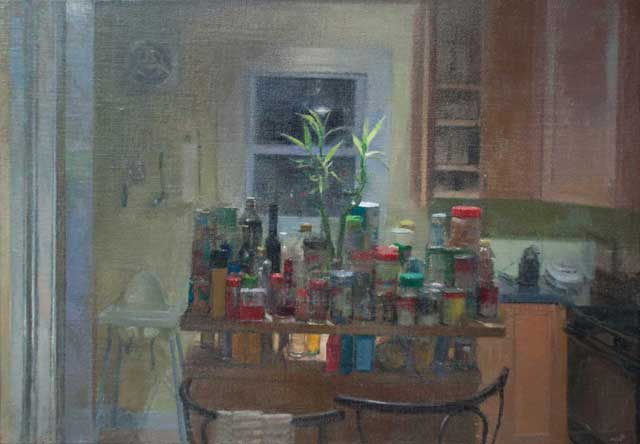
Ants! oil on linen panel 16″ x 23 1/2”
LG: Please tell us something interesting about how you became the kind of painter you are today.
MK: Undoubtedly “interesting” is a relative term but the first painting I made in the long series I feel that I’m still working within, namely, interiors, began after a discouraging day of critiques. At the time I was in undergrad at CCAD (Columbus College of Art and Design) and was supposed to be working on a series of works for my senior exhibition. I still had no clue what I wanted to paint (I only knew that I wanted to paint) and I was working on these elaborate illustrative epics that were intended to bring heightened awareness to any viewer within a three mile radius. Needless to say, this was not happening and the paintings were absolute disasters. So, I sat down after a long day of classes and began to paint a scene which I thought to be strangely interesting. The majority of the picture was the flat underside of a stairwell that descended above the basement steps. I remember my roommates grumbling as they sidled past my chair which was planted squarely in the hallway as I peered down the stairs while painting this picture. After a week of painting late into the night I completed my first interior and have been excited about this genre ever since. If I had known that this choice would lead the way to over a decade of basement paintings I might have thought twice. Now, I venture out into the daylight and paint the landscape from time to time.
After the more open studio spaces I made a bunch of cluttered kitchen paintings and now basement paintings. I wondered if it would be possible to synthesize all of this assertive data in a shallow space into something with rhythm and balance. The studio spaces were just as packed with information but it was understated and subtle. Could a bunch of brightly colored synthetic objects be gathered into one cohesive whole? While painting the kitchen paintings from close proximity (in Watched Pot for example) my cone of vision would severely bend and I was challenged equate one quadrant of the painting to another. I was in uncharted territory and my usual pictorial conventions wouldn’t work so I was forced to stack elements or pinch them closer together. I was so close to the fridge that I had to move my easel every time I needed a snack.
LG: What is your usual process with painting? Do you start with a careful drawing first or do you work the drawing in the paint? Anything of interest about your particular palette?
MK: I hardly ever do any careful drawing. My paintings start on a toned ground and I work with successively more contrasting lines coupled with smears of blocked in color. I like to get straight to the painting and, initially, make many bad decisions through my lack of careful drawing. It seems to me that this initial floundering is somehow important but it’s hard pinpoint the reason I feel that way. Occasionally, when I am quite far in the life of a painting it may be necessary to paint over large areas or add panels to the work. You may see that In Her Place is comprised of three separate panels and the painting started as the square panel in in the upper right.
My palette has become much simpler over the years. I often begin a painting with three to five colors and then may need to add one or two additional colors along the way to achieve a certain chromatic range.
Watched Pot 32 x 24 inches Oil on Panel
American Icon oil on panel 12 x 10 inches
Daylight Studio 36 x 29 inches
LG: What aspect of your painting gives you the greatest satisfaction? What gives you the greatest aggravation?
MK: Certainly the act of painting, or the thrill of the hunt, is what satisfies me most. I enjoy looking and the magic of weaving together an image from mixed paint color. I do a lot of scraping away and sanding down in my longer studio paintings. It is wonderfully satisfying when I create an underlayment to a picture and can add detail and subtle modulation to the surface so that the whole thing comes together. Painting the landscape, something I’ve done plein air for the last few years, has also been very satisfying. The approach is very different but it is a wonderful challenge and I enjoy making any sort of work that will most expediently represent the scene I’m interested in.
I’m most aggravated by long intervals between painting sessions on a particular painting. I often have a number of paintings in progress at one time but don’t necessarily stick to any one thing. Sometimes weeks will go by without going back to a particular work and by the time I do, the painting ceases to be about what it was initially. It’s like waking up and being horrified that you can’t clearly recollect a beautiful dream. Often, I’ll completely sand down a painting that I’ve lost the creative thread for and many of my paintings have the ghosts of one or several paintings under their surface.
LG: Who are your top three painters in terms of how they influenced your work.
MK: Antonio Lopez Garcia, an uncompromising observer and methodical technician. His ability to let go and allow the ever changing realities of light and observation lead the painting is influential. His surfaces are unbelievably textured and varied.
Edwin Dickinson, his line and the lyric quality of his works are amazing. He strikes me as the quintessential American painter… as much as Eakins even. I like that he is American but subtle. There’s grit in his work but poetry and sensitivity too.
Albert York, I’ve grown to like this artist over the past few years. The best artists are those that can show the greatest range between tones/colors and he is great on both accounts. He can push things down so far that your eyes need to adjust to see the paintings. Also, I like how he plays with picture making and pictorial space. Early Morning After the Snow is a painting that I did from memory and this was influenced by the freedom that I see in York’s work.
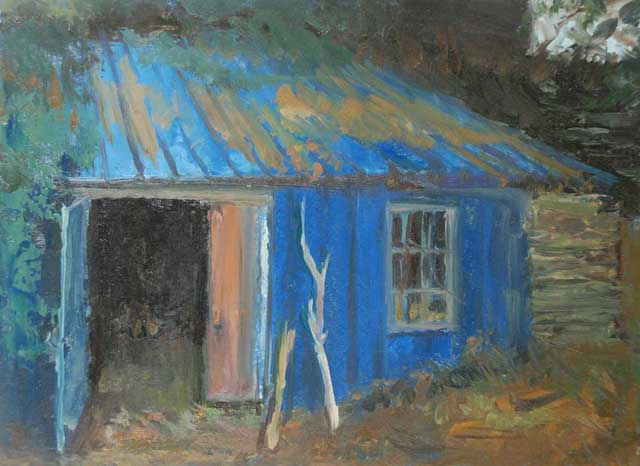
Woodshed 8 x 11 inches oil on board
Morning at the Docks 11 x 12 oi on panel
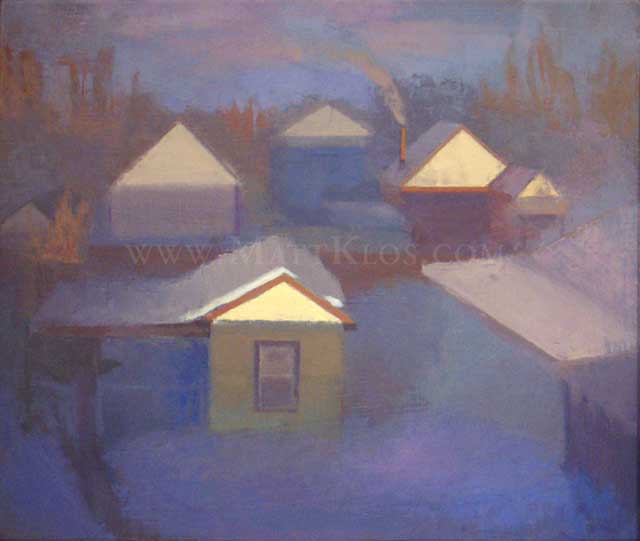
Early Morning after the Snow 24 x 24 inches

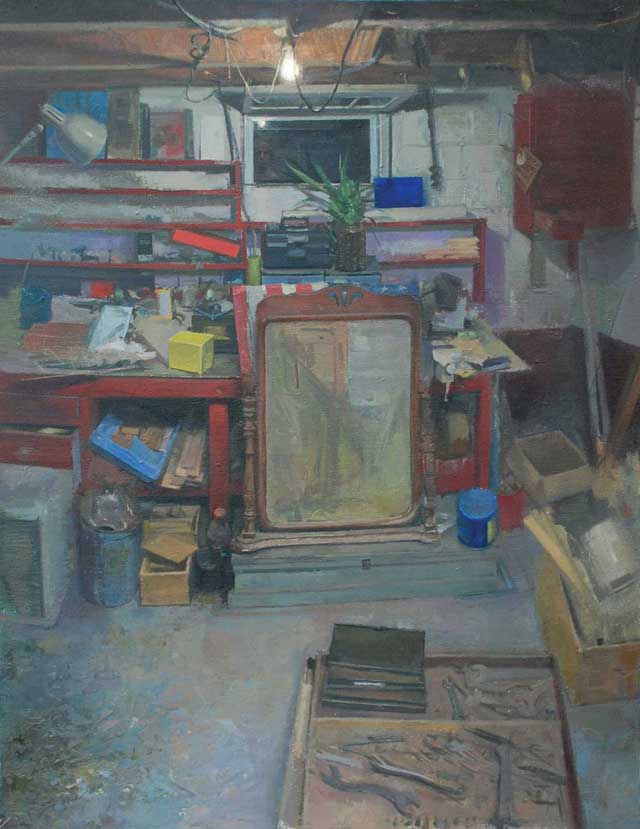
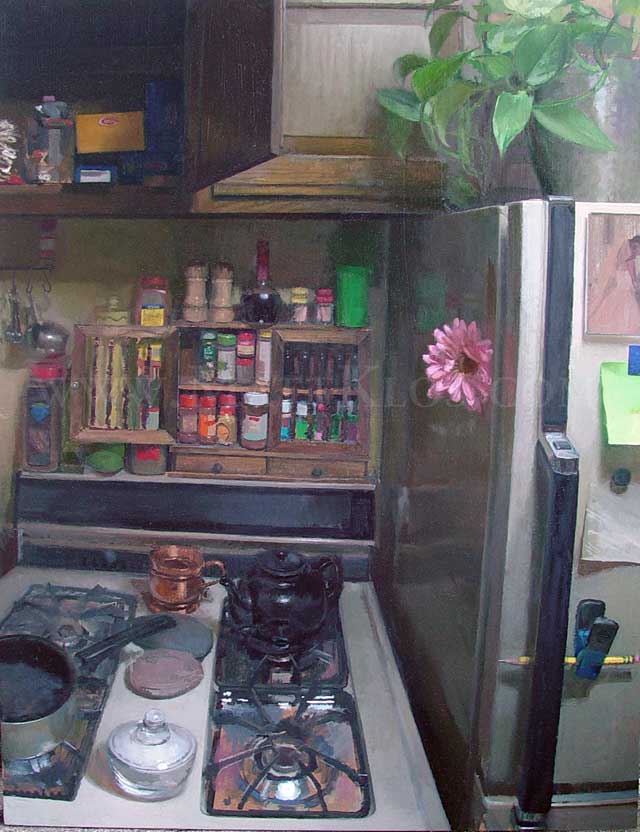
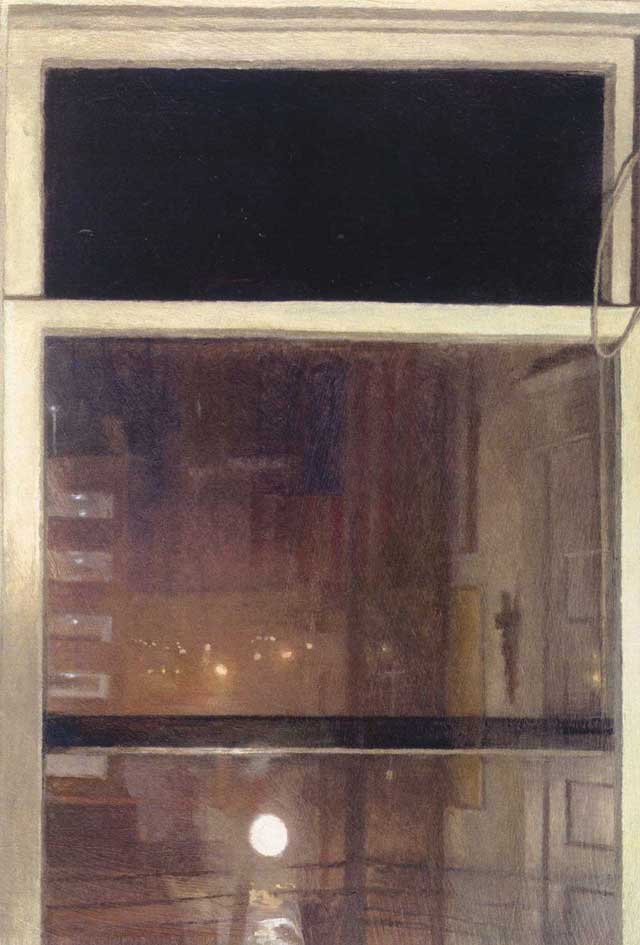

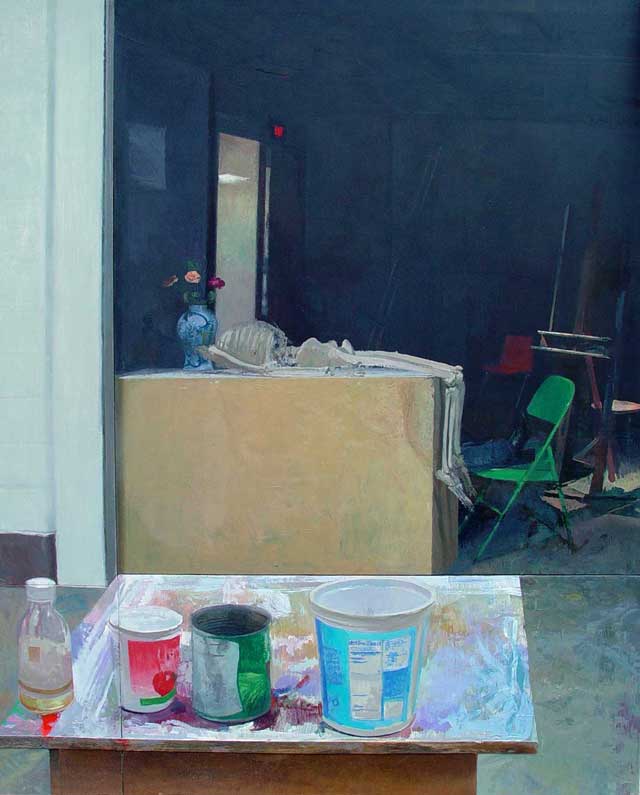
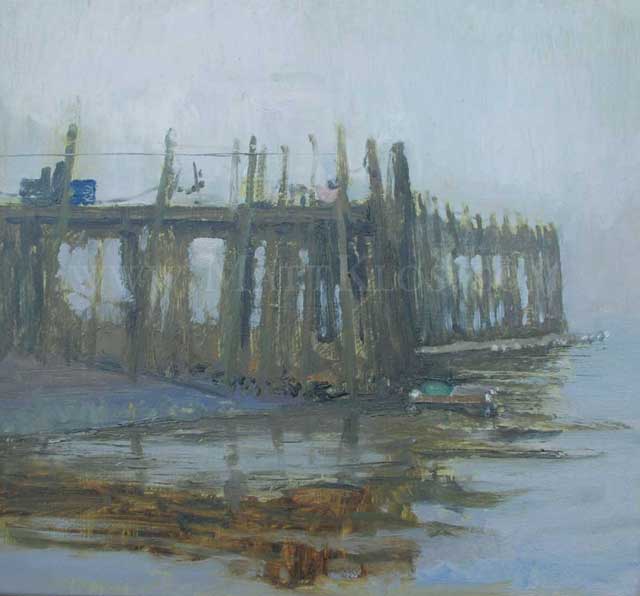
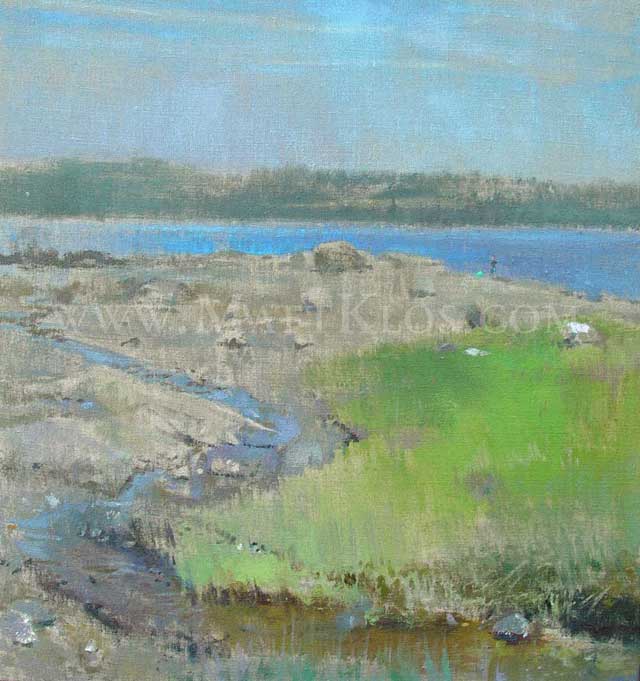




Very nice paintings, Matt. I like the claustrophobic space in the basement paintings…how you’ve ordered the chaos. Your have these great passages of forms in the compositions, funny little things like the pencil on the refrigerator handle and the dangling wires and lights. I also love the surprising nuances of colors that pop out from the grayed down palette (the lavender and blues, especially) Keep up the good work!
Excellent paintings. Nice feeling of objects and space without being over-rendered.
Wonderful interview and TERRIFIC paintings!!!
Lovely paintings and I really enjoyed the interview!
I love these paintings. It’s good to know that they exist in the world. Looking forward to seeing more.
i love the lucidity and joy with which klos talks about painting and looking and being present in the world. we need more of this.